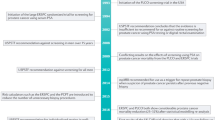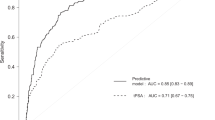Abstract
BACKGROUND: Various interferences can cause spurious results for common laboratory tests. Although rare, heterophilic antibodies may produce false elevations in PSA that could prompt unnecessary therapy in men previously treated for prostate cancer. The aim of this study was to determine the prevalence of small, spurious PSA elevations, and the role of heterophilic antibodies.
METHODS: Phase I: all PSA tests drawn and measured between 27 October 2008 and 26 October 2010 at Vanderbilt University Medical Center were analyzed (n=17 133). Patients who had been treated for prostate cancer with PSA values that changed from undetectable to detectable were evaluated. Phase II: patients with a detectable PSA ⩽0.5 ng ml−1 measured between 24 October 2010 and 19 January 2011 were studied prospectively (n=1288). If any patient had a previously undetectable PSA value, their serum was tested for heterophilic antibody interference.
RESULTS: Phase I: 11 men had a spuriously elevated PSA after curative treatment for prostate cancer (0.3%). Mean time to PSA elevation was 3.4±5.5 years, and mean elevation in PSA was 0.33±0.28 ng ml−1. Each patient's PSA was undetectable after being repeated, and no patient went on to unnecessary treatment. Phase II: 10 men had a newly detectable PSA, 9 of whom had a history of prostate cancer. Each tested negative for interfering heterophilic antibodies when their PSA test was repeated with a heterophilic antibody-blocking reagent.
CONCLUSIONS: In a large cohort, we estimate the prevalence of spuriously elevated PSA values in our population to be 0.3%. No patient with a prostate cancer history was subjected to unnecessary diagnostic evaluation or treatment. On prospective evaluation of PSA conversion to low detectable levels, no patient had evidence of interfering heterophilic antibodies. When using PSA for post-treatment surveillance, it is crucial to confirm all concerning values and consider the presence of a spurious elevation in PSA if the value does not correlate with the clinical scenario.
This is a preview of subscription content, access via your institution
Access options
Subscribe to this journal
Receive 4 print issues and online access
$259.00 per year
only $64.75 per issue
Buy this article
- Purchase on Springer Link
- Instant access to full article PDF
Prices may be subject to local taxes which are calculated during checkout



Similar content being viewed by others
References
Loeb S, Schaeffer EM, Chan DW, Carter HB, Walsh PC, Sokoll LJ . Investigation of human anti-mouse antibodies as potential cause of postprostatectomy PSA elevation. Urology 2009; 73: 947–949.
Sturgeon CM, Duffy MJ, Stenman UH, Lilja H, Brunner N, Chan DW et al. National Academy of Clinical Biochemistry laboratory medicine practice guidelines for use of tumor markers in testicular, prostate, colorectal, breast, and ovarian cancers. Clin Chem 2008; 54: E11–E79.
Henry N, Sebe P, Cussenot O . Inappropriate treatment of prostate cancer caused by heterophilic antibody interference. Nat Clin Pract Urol 2009; 6: 164–167.
Fritz BE, Hauke RJ, Stickle DF . New onset of heterophilic antibody interference in prostate-specific antigen measurement occurring during the period of post-prostatectomy prostate-specific antigen monitoring. Ann Clin Biochem 2009; 46 (Pt 3): 253–256.
Park S, Wians Jr FH, Cadeddu JA . Spurious prostate-specific antigen (PSA) recurrence after radical prostatectomy: interference by human antimouse heterophile antibodies. Int J Urol 2007; 14: 251–253.
Morgan BR, Tarter TH . Serum heterophile antibodies interfere with prostate specific antigen test and result in over treatment in a patient with prostate cancer. J Urol 2001; 166: 2311–2312.
Camacho T, Mora J, Segura A, Guitian J, Lema F, Bandin J et al. Falsely increased prostate-specific antigen concentration attributed to heterophilic antibodies. Ann Clin Biochem 2002; 39 (Pt 2): 160–161.
McAuley I, Steinhoff G, McNeely M, Blood P . Incorrect biochemistry complicates prostate cancer management. Can J Urol 2002; 9: 1496–1497.
Kummar S, Shafi NQ . False elevations in prostate-specific antigen levels affecting patient management. Clin Adv Hematol Oncol 2004; 2: 599–601; discussion 2.
Warren DJ, Bjerner J, Paus E, Bormer OP, Nustad K . Use of an in vivo biotinylated single-chain antibody as capture reagent in an immunometric assay to decrease the incidence of interference from heterophilic antibodies. Clin Chem 2005; 51: 830–838.
Boscato LM, Stuart MC . Heterophilic antibodies: a problem for all immunoassays. Clin Chem 1988; 34: 27–33.
Cantor D . Reason for limitations of heterophilic blocking tube use on certain beckman coulter access assays. Clin Chem 2005; 51: 1311.
Bertholf RL, Johannsen L, Guy B . False elevation of serum CA-125 level caused by human anti-mouse antibodies. Ann Clin Lab Sci 2002; 32: 414–418.
Sapin R, Simon C . False hyperprolactinemia corrected by the use of heterophilic antibody-blocking agent. Clin Chem 2001; 47: 2184–2185.
Pathologists CoA. K-18 General Ligand Assay Participant Summary. General Ligand Assay Proficiency Testing 2011.
Kaplan LA, Pesce AJ . Clinical Chemistry: Theory, Analysis, and Correlation. 3rd ed. Mosby: St Louis, 1996.
Boscato LM, Stuart MC . Heterophilic antibodies: a problem for all immunoassays. Clin Chem 1988; 34: 27–33.
Preissner CM, Dodge LA, O’Kane DJ, Singh RJ, Grebe SK . Prevalence of heterophilic antibody interference in eight automated tumor marker immunoassays. Clin Chem 2005; 51: 208–210.
Ismail Y, Ismail AA . Erroneous laboratory results: what clinicians need to know. Clin Med 2007; 7: 357–361.
Bjerner J, Nustad K, Norum LF, Olsen KH, Bormer OP . Immunometric assay interference: incidence and prevention. Clin Chem 2002; 48: 613–621.
Boerman OC, Segers MF, Poels LG, Kenemans P, Thomas CM . Heterophilic antibodies in human sera causing falsely increased results in the CA 125 immunofluorometric assay. Clin Chem 1990; 36: 888–891.
Levin O, Morris LF, Wah DT, Butch AW, Yeh MW . Falsely elevated plasma parathyroid hormone level mimicking tertiary hyperparathyroidism. Endocr Pract 2011; 17: e8–11.
Ross HA, Menheere PP, Thomas CM, Mudde AH, Kouwenberg M, Wolffenbuttel BH . Interference from heterophilic antibodies in seven current TSH assays. Ann Clin Biochem 2008; 45 (Pt 6): 616.
Spencer DV, Nolte FS, Zhu Y . Heterophilic antibody interference causing false-positive rapid human immunodeficiency virus antibody testing. Clin Chim Acta 2009; 399: 121–122.
Butler SA, Cole LA . Use of heterophilic antibody blocking agent (HBT) in reducing false-positive hCG results. Clin Chem 2001; 47: 1332–1333.
Zhu Y, Jenkins MM, Brass DA, Ravago PG, Horne BD, Dean SB et al. Heterophilic antibody interference in an ultra-sensitive 3-site sandwich troponin I immunoassay. Clin Chim Acta 2008; 395: 181–182.
Hunter WM, Budd PS . Circulating antibodies to ovine and bovine immunoglobulin in healthy subjects: a hazard for immunoassays. Lancet 1980; 2: 1136.
Leibowitz SB, Oh WK . Overtreatment of a patient with presumed recurrent prostate cancer based on false-positive prostate specific antigen results. J Urol 2003; 170 (4 Pt 1): 1305.
Bjerner J, Bormer OP, Nustad K . The war on heterophilic antibody interference. Clin Chem 2005; 51: 9–11.
Soletormos G, Semjonow A, Sibley PE, Lamerz R, Petersen PH, Albrecht W et al. Biological variation of total prostate-specific antigen: a survey of published estimates and consequences for clinical practice. Clin Chem 2005; 51: 1342–1351.
Cookson MS, Aus G, Burnett AL, Canby-Hagino ED, D’Amico AV, Dmochowski RR et al. Variation in the definition of biochemical recurrence in patients treated for localized prostate cancer: the American Urological Association Prostate Guidelines for Localized Prostate Cancer Update Panel report and recommendations for a standard in the reporting of surgical outcomes. J Urol 2007; 177: 540–545.
Author information
Authors and Affiliations
Corresponding author
Ethics declarations
Competing interests
The authors declare no conflict of interest.
Rights and permissions
About this article
Cite this article
Anderson, C., Pyle, A., Woodworth, A. et al. Spurious elevation of serum PSA after curative treatment for prostate cancer: clinical consequences and the role of heterophilic antibodies. Prostate Cancer Prostatic Dis 15, 182–188 (2012). https://doi.org/10.1038/pcan.2011.58
Received:
Revised:
Accepted:
Published:
Issue Date:
DOI: https://doi.org/10.1038/pcan.2011.58



